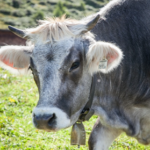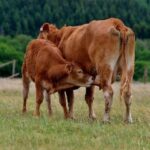Hereford cattle are a breed that originated in Herefordshire, England. This breed is pretty popular worldwide.
Hereford cattle are docile and range in size from medium to big. The hue ranges from rust to rich red, with white markings. This breed comes in both horned and polled varieties and has a low milking capacity .Hereford breed was named after the county of Herefordshire, where it originated.
Keeping all of these characteristics in mind, we’ll add some more interesting facts about the Hereford cattle breed in this article. And to do so, we’ll go over everything, from their origins and hues to their functions.
You will discover a lot about the Hereford breed by the end of the post, which will help you understand it better. So, without much ado, let’s begin the journey!

Hereford cattle facts
Hereford cattle are robust, tough, and sturdy creatures.
Below are some fundamental facts about Hereford cattle that will aid in a better understanding of their characteristics.
| General name | Hereford |
| Origin | Herefordshire, south-west England |
| Breed size | Medium to large |
| Milking capacity | Poor to medium |
| Temperament | Docile |
| Horned | Yes |
| Climate tolerance | From the arctic to hot climate |
| Coat color | Rust brown to rich red with white markings |
| Health issues | Sickness in Eye; dwarfism |
Hereford cattle physical characteristics
One of the most popular cattle breeds globally is Hereford cattle. These cattle are well-known for their vitality and foraging capacity.
Here are some physical traits that identify Hereford cattle:
- These animals range in size from medium to large.
- Herefords are distinguished by their deep red coats, white faces, and white markings.
- They mature at a young age.
- Cattle from the Hereford breed have a blocky look.
- Muscle bulk is common in Hereford bulls’ shoulders, necks, and underparts.
- Hereford males can weigh up to 1800 pounds.
- Female cows can weigh as much as 1200 pounds.
The coat color and white markings of this breed, on the other hand, make them easily identifiable. Even if you only see them once, you will be able to recognize them.

Hereford cattle origin
As previously indicated, Hereford cattle take their name from the region where they were originated. This breed belongs to the bovine category and is a warm-blooded mammal.
The Hereford is a British cow breed that originated in Herefordshire, England. However, Henry Clay had introduced Herefords to the United States in 1817 by importing one bull and two female bovines from Kentucky. That being said, William H. Sotham and Erastus Corning commenced breeding this herd in the United States in 1840.
However, it’s worth noting that Herefords in the early days of England were much bigger than they are now, weighing in at over 3,000 lbs.
Why are Hereford cattle so popular?
Hereford is easy to recognize cattle breed, thanks to their reddish coat color. But makes this breed so popular worldwide?
Herefords are noted for their high reproductive rates and calving ease, even as they get older. Furthermore, they are well-known for their forager abilities, adaptability, and cross-breeding effectiveness.
Hereford cattle reproductiveness
Reproduction plays a big role in the bovine industry. Therefore, birthing ease and better calving capacity are highly desirable.
The Hereford cows are noted for their high reproductive rates. In fact, this breed is one of the most prolific kinds in this category. One of the distinctive characteristics of Hereford cows is their ability to reproduce calves even in their senior years. Furthermore, these cows have a very low rate of birth problems.
Sometimes female Herefords live over 15 years and are capable of delivering calves.
Many breeders preserve their elderly cattle until they die naturally because of their high reproduction rate and long breeding capabilities.
Hereford cattle weight
Hereford cattle, as previously stated, belong to the medium to large frame bovines.
A mature male Hereford can weigh up to 1,800 pounds, whereas grown up females can weigh as little as 1,200 pounds. You can also find pronounced and desirable cuts near the areas of the back, shoulder, and hind legs.
But the initial Hereford breeds from England weighed much heavier than what we see today. In fact, they used to weigh over 3000 pounds. However, the type and structure eventually altered to a less dramatic body mass to improve the breed’s smoothness, quality, and productivity.
Hereford cattle size
Hereford cattle tend to have a rounded body shape, with a stout overall physique.
These cattle can weigh up to 1800lbs (maximum.). However, as far as the length is concerned, they can be as tall as 152 cm.
Hereford cattle color

One of the most recognizable traits of cows is their coat color. Their color can easily help us recognize them without more intricate details.
Hereford cattle’s coat colors range from rust copper to rich red, with a white face and markings. Whitesides and white marks below the knees and hindquarters are also prevalent in Herefords.
Hereford cattle temperament
Herefords have a blocky appearance and a calm expression on their faces. And, because they are so well-known, we are frequently curious about their true temperament.
Herefords are known for their obedience, making it easier to manage and work with. In addition, the pleasant disposition of this breed, which weighs more than 1,000 pounds, is a vital safety factor for ranchers and cow producers.
Researchers have also discovered that Hereford cattle have fewer stress hormones, which adds to their versatility.
Hereford cow milking capacity
The milking capacity of cows plays a big role in the dairy industry. But not all bovine breeds are bred for milk production.
That being said, the milk yield of Hereford cows cannot be counted amongst the best dairy breed cows. Nonetheless, these cows can produce enough milk for their calves, standing at 11.4 lbs per day.
Pros and cons of Hereford cattle

So, Herefords are popular. But they are not devoid of their share of cons. Here, we have shed light on both pros and cons of Hereford cattle.
Pros:
- Highly reproductive breed
- Efficient mothering abilities
- Good longevity
- Easy to manage
- Great foragers
- Matures earlier than Brahman
- Easily to recognize due to their coat color and markings
- Ideal for cross-breeding
- Easy milking process
Cons:
- Although versatile, it cannot bear (too much) extreme environment
- Sudden climatic changes are not good for this breed
- Prevalence of dwarfism
- Prone to get sunburnt
Summary
Undoubtedly, Hereford are beautiful and are known for their rusty coat color and white markings. And if you are a novice in bovine handling and planning to get yourself a bull or a cow, choose the Hereford breed. Their ease of handling and docile temperament would surely win your heart.





